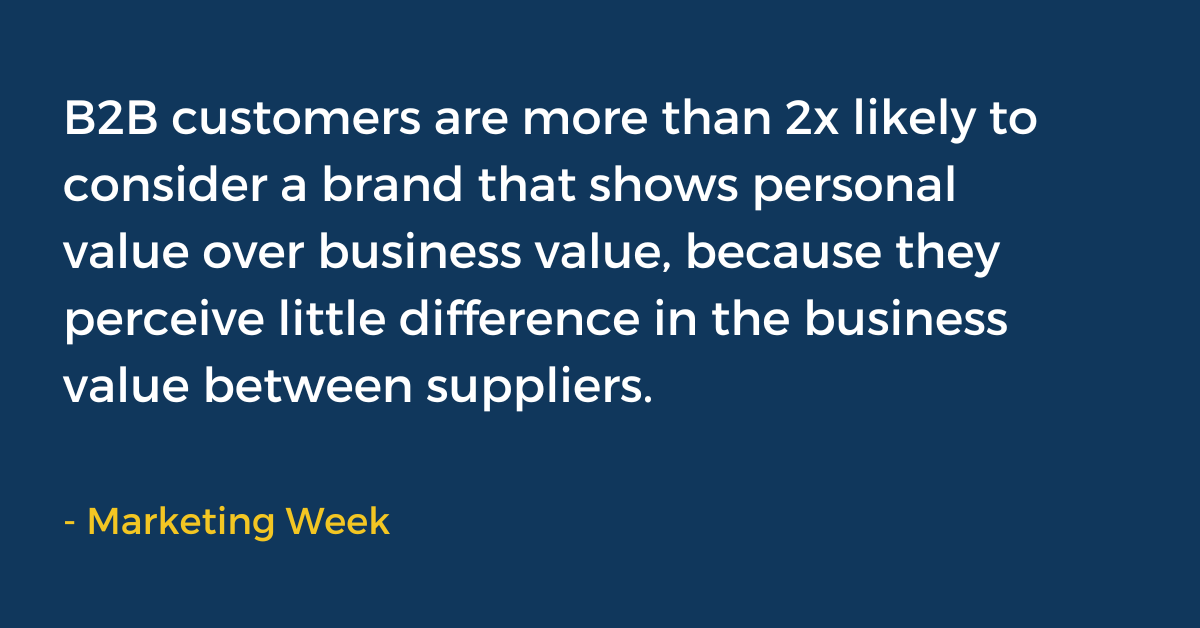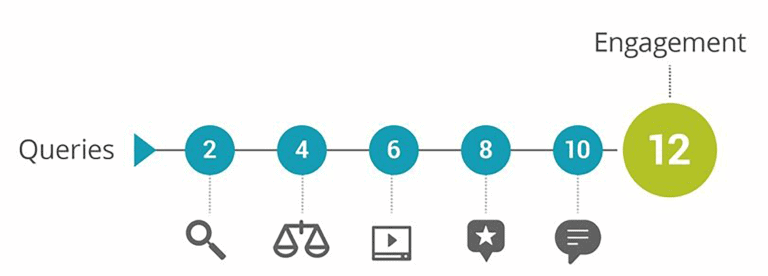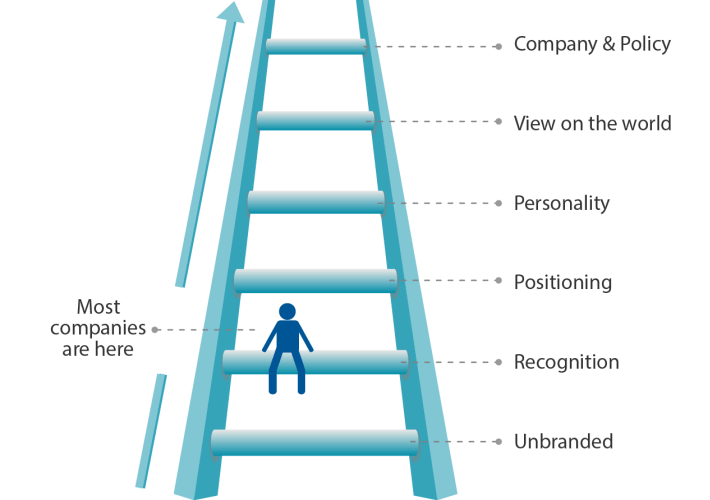A quarter of B2B businesses invest only 5% of their total budgets on marketing and branding.
The reason:
Since time immemorial, businesses that sell to other businesses feel “product specifications” and “one-on-one interactions with salespersons” are the only two factors that can drive home sales.
But that’s not true.
B2B branding is an important driver of sales and revenue. Here’s how:

But I cannot invest in B2B branding, just based on the “likelihood” that customers will consider my company over competitors.
Well, you don’t have to. Because there is tangible evidence that suggests…
B2B branding builds market share and boosts bottom lines.
How? In 3 ways:
1. Building trust
Data suggests that before interacting with a B2B website, an average buyer will conduct 12 online searches. That means buyers don’t trust any business in one go. You need to persistently brand your business so that trust is established.

How does trust relate to market share and bottom lines?
Well, 46% of customers in a Salsify survey mentioned that they’d be willing to pay more for brands that they trust.
Thus, with branding efforts directed at building trust, you can get your business users to pay a premium for your products and services with ease.
Read More: The impact of New technologies (such as AI) on Logo design
2. Attracting new customers
No matter how many leads your sales team brings via outbound marketing, you can sure do with some more, right?
And B2B branding is a surefire way to attract new customers. Primarily due to the availability heuristic.
Obviously, price, features, benefits, and data drive business buying decisions. But business decision-makers are also people. And they do use mental shortcuts (called heuristics) to make snap judgments.
So if they have seen, heard of, and engaged with your business brand before, they’ll subconsciously give you a higher preference.
And given that only a small percentage of B2B companies care about branding today, you’ll have a definitive edge if you do invest in B2B branding.
3. Reassuring old customers of their choice and ensuring loyalty
Did you know that loyal customers spend 67% more than new ones?
In the B2B domain, where the cost of a single sale is much higher, retaining old customers can mean having a golden goose for a pet.
By consistently branding your business, you can associate a pride factor with your name. And with that, you can make past customers feel good about their association with you.
The result? Higher customer retention. And more repeat contracts/purchases.
Ready for some B2B branding action? Remember to use the right strategies though. Don’t mistakenly use B2C branding tactics here or you’d be set for failure.
Why?
Because B2B and B2C branding are vastly different. And so is the branding in these 2 markets.
Here’s a quick summarization of how B2B branding differs from its B2C counterpart.
B2B vs. B2C branding – Key differences
| Factor | B2B Branding | B2C Branding |
|---|---|---|
| Customer Motivation | Purchases are motivated by facts and logic. Fear of failure is the predominant emotion.
Branding as an “expert” helps ease this fear and drive home sales. |
Purchases are driven by a myriad variety of emotions including fear, desire, attraction, etc.
Branding needs to be done to appeal to the target audience’s emotions. |
| The number of customers | B2B products are meant for use by larger groups of people.
Branding efforts should thus, appeal to all the stakeholders involved. |
B2C products are usually for individual consumption.
Branding needs to be directed at pleasing individuals only. |
| Range of customers | B2B companies serve niche audiences. Thus, should brand themselves as experts in the niche. | B2C companies serve a wider range of audiences. Thus, should brand themselves as accessible/available for all. |
| Buyer persona | A B2B buyer persona is focused on job roles and titles, not specific individuals | A B2C buyer persona is focused on individuals and their demographic characteristics. |
| Customer relationship | B2B businesses need to build long-term relations with customers.
They need to be branded as one-stop solution providers. |
B2C businesses usually have one-time transactional relations with customers.
They may or may not need to be branded as long-term partners. |
| Product information | B2B branding needs to convey expertise via product information. | B2C branding can stay more focused on direct and immediate benefits. |
| Sales cycle | B2B sales cycles are longer and involve various rounds.
The goal of B2B branding is to build trust during this cycle. |
B2C sales cycles are shorter, sometimes mere seconds or minutes.
The goal of B2C branding is to have a quick emotional impact or appeal. |
| Conversions | The end goal of B2B branding is to turn prospects into hot leads. Salespersons hammer the final nail of converting them. | The end goal of B2C branding is to turn audiences into paying customers. Salespersons have little to no role. |
How to start building a B2B brand?
Before setting out on the quest to build your B2B brand, understand which rung of the branding ladder you sit on.

Once you know where you are, follow the 6-step process mentioned below and build a strong B2B brand for your business.
1. Identify goals and purposes
Find out what you want to achieve with branding. Do you just need to build brand awareness? Do you also want to get more hot leads?
Depending on the goals, the actual strategies will differ.
2. Define audience personas
Find, understand, and define who your target audience is. Then build the audience personas accordingly.
3. Strategically position your business in the market
Based on your goals, position yourself as a market leader, expert, support provider, etc. in the market.
4. Differentiate yourself from competitors
Highlight, not just product specifics, but also emotional and psychological aspects that set you apart from your competitors.
5. Create a brand character that your audience will connect with
Personify your brand. Business decision-makers don’t want to transact with lifeless buildings, but with brands with strong characters.
6. Tell your brand story through key messaging
Make sure your branded content tells your brand story. Ensure consistency in brand messaging.
Read More: How to build successful brands: SeekThem branding process
Kickstart your B2B branding journey today
Now you know how important B2B branding is. You also know how to plan and implement your B2B branding strategy.
So what’s keeping you from kickstarting the journey today?
Ah, I get it!
- You already have a lot on your plate with no time left for helming the branding campaign.
- Or branding isn’t your area of expertise and you don’t want to learn it from scratch.
Either way, here’s what you can do: Hire branding agencies.
With an agency, you get
- A team that becomes an extension of your own. Without the overheads.
- Years of experience. Without having to try and fail first.
- Scope for scaling your branding efforts up and down. Instantly. Without the usual time lags involved.
- Expertise that will help you race ahead of the competitors. Without the cost of in-house hiring.
Don’t wait anymore. Hire a B2B branding agency and get going towards growth.


